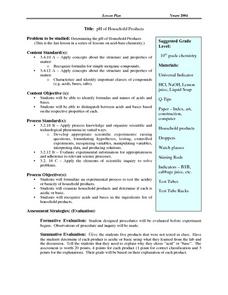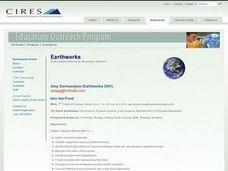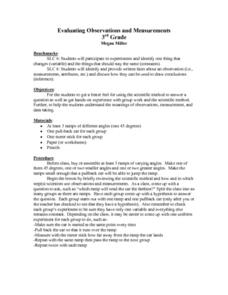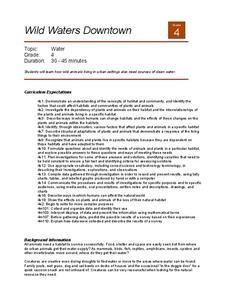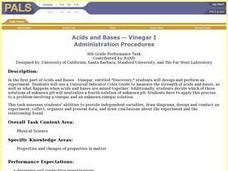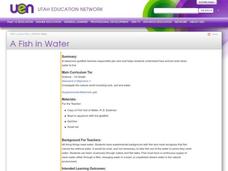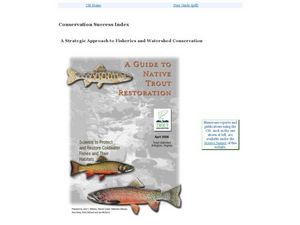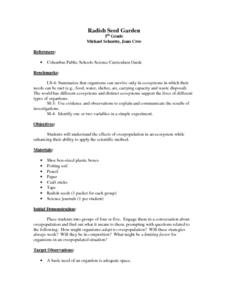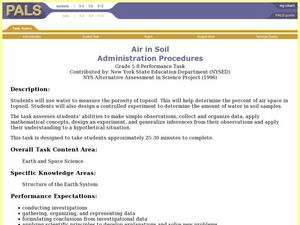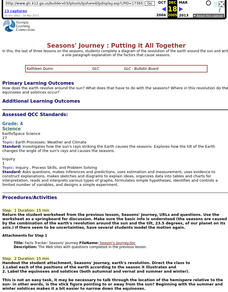Curated OER
Temperature Variations and Habitability
Young scholars, in groups, evaluate conditions outside the building and inside the classroom using thermometers, barometers, anemometers, etc. They compare interior and exterior conditions. They consider and discuss factors that...
Curated OER
Scientific Investigation- Magnets
Students conduct a scientific investigation to determine if a magnet attracts paper clips through different materials. Students write out their procedures, collect data and present it in a table or chart, and analyze their results.
Curated OER
A Human-Powered Vehicle for Trans-Glacial Transport
Students practice problem solving skills and experimental design. They build a vehicle that can traverse "glacial" ice capable of carrying a specific load and glide smoothly, creating as little effort as possible for the skier pulling...
Curated OER
Termite Trails
Students observe the behavior of termites and draw conclusions about their behavior. They record data as to termite behavior and recognize elements in the experimental design which must include a hypothesis.
Curated OER
pH of Household Products
Tenth graders are provided with a piece of paper such as index, art, construction, or computer coating it with a universal indicator. They use cotton swabs HCl and NaOH to draw a picture repeating the same process using lemon juice and...
Curated OER
Into the Pond
Seventh graders use a pond to explore macroinvertebrates and other organisms. They use a dichotomous key to classify the organisms and maintain a journal recording their findings.
Curated OER
Evaluating Observations and Measurements
Third graders review the scientific method and how and in which steps scientists use observations and measurements. Then as a class, they hypothesize which ramp will send the car the farthest. They break into groups and send cars down a...
Curated OER
Wild Waters Downtown
Fourth graders investigate how wild animals living in urba settings also need sources of clean water. They discuss the open water issues of West Nile Virus and what happens to urba animals as these poolings area are cleaned up. ...
Curated OER
Acids And Bases -- Universal Indicator
Eighth graders design and perform an experiment that uses a Universal Indicator Color Guide to measure the strength of acids and bases. They also determine happens when acids and bases are mixed together. They decide which of three...
Curated OER
Lichens as Air Quality Indicators: A beginning lichen identification study (2003
Students use GPS and trees to explore lichens and air quality.
Curated OER
Observing and Classifying Rocks
Fourth graders examine various types of rocks and record their properties. They collect rocks at home and bring them to school where they are mixed and distributed to groups of students. After writing their observations on...
Curated OER
Wat-er We Good For?
Fifth graders investigate the use of water as a resource that needs to be conserved. They practice the skill of water conservation by taking a home survey of water usage and modify the use in order to decrease the wasting of water.
Curated OER
Your Body's Building Blocks
Young scholars study the elements of the Periodic Table as they relate to the building blocks of the body. They experiment to measure the amount of iron in the body.
Curated OER
A Fish in Water
First graders, with a goldfish as a class pet, practice the proper way to care for a pet and have responsibilities when it comes to taking care of the fish. As a class, the teacher reads the book "Fish Out of Water".
Curated OER
Bubbles
Students complete experiments with three different bubble solutions to determine which one creates the largest bubbles. Before conducting the experiments, they discuss the ingredients in each solution, and make predictions on which will...
Curated OER
Conservation Success Index
Students read information about trout habitat preservation and visit the various links to learn a fish species and its current habitat range. For this habitat conservation lesson, students read passages about use the Trout Unlimited...
Curated OER
Gas Laws
Eighth graders use lab work and software to collect and analyze pressure and temperature data in order to illustrate the relationship between the temperature and pressure of a gas at a constant volume. They conduct a lab and organize...
Curated OER
TE Activity: Built to Last?
Fifth graders test the shelters that were built in a prior activity. They determine the level of durability and water resistance of these shelters through a scientific investigation.
Curated OER
Farming in a Fishbowl: How Ethnic Groups in
Seventh graders research Chinese agricultural needs and practices. They conduct an experiment with aquaculture and germinated rice as they take measurements and apply the scientific method.
Curated OER
Yeast Cells and Their Environment
Middle schoolers create their own experiment in which they have yeast cells growing in liquid environments. They examine the relationship between humans and microorganisms. They also practice using the scientific method.
Curated OER
Testing the Hypothesis
Students create and conduct various experiments to determine the origin of a family artifact, and then determine whether their results were successful. Students summarize their results and evaluate whether their hypotheses were correct.
Curated OER
Radish Seed Garden
Fifth graders explore the effects of overpopulation in an ecosystem while applying the scientific method. They discuss overpopulation and its meaning. Students as an organism competes for space in an overpopulated area. They plant...
Curated OER
Air in Soil Administration Procedures
Students study soil and its composition. In this soil composition lesson, students study examples of soil during several days of aeration. Students summarize their data, organize it, and must be able to explain their findings.
Curated OER
Seasons' Journey : Putting it All Together
Third graders complete a diagram of the revolution of the earth around the sun and write a one paragraph explanation of the factors that cause seasons.






